|
|
|
|
|
|
|
Achi-Kochi Japan
Showing many places to visit and foods to eat in Japan
|
|
|
|
|
|
|
|
|
|
|
|
|
Japan
> Themes
> History vol.2 Samurai Age
|
|
|
|
|
|
|
A Hisotry of Japan
vol.2 Samurai Age
( Achi-Kochi Japan )
|
|
|
|
|
|
|
|
|
|
|
|
|
( "Achi-Kochi" in Japanese means "Here and there" in English. )
Kamakura Period
In A.D.1180, Kiyomori Taira made Emperor Takakura abdicate and enthroned Emperor Antoku who was born in A.D.1178. The Emperor's mother was a daughter of Kiyomori. So Emperor Antoku was a grandson of Kiyomori Taira, who died in A.D.1181. At the time, the downfall of the Taira clan had already started.
The war between two samurai groups, the Taira clan and the Minamoto clan, started in A.D.1180 and the Taira clan was decisively destroyed in A.D.1185. Yoritomo Minamoto, the leader of the Minamoto clan, did not dominate the Imperial Court as Kiyomori Taira did. But Yoritomo Minamoto established Kamakura Shogunate in Kamakura, which became the political centre while Kyoto remained the capital city of Japan officially.
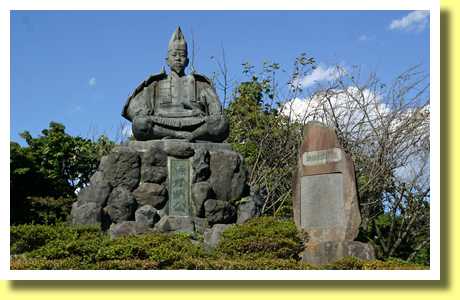
Yoritomo Minamoto is the 1st shogun of the 1st shogunate established in Japan. The above photo shows a statue of Yoritomo which stands in Kamakura City, Kanagawa Prefecture, Kanto region.
Kamakura Shogunate, a military government, failed to maintain peace. In A.D.1221, the retired Emperor Go-Toba raised an army to recover the political power from the shogunate. After the failure, the retired Emperor Go-Toba was exiled to Oki Island, where he died in A.D.1239.
In A.D.1270, the Korean kingdom of Goryeo became a subordinate state of the Yuan dynasty ( Mongol ), which sent hundreds ships and tens of thousands of Mongolian and Korean warriors to conquer Japan in A.D.1274. They landed on Komodahama beach, Tsushima island ( now a part of Nagasaki Prefecture, Kyushu region ).
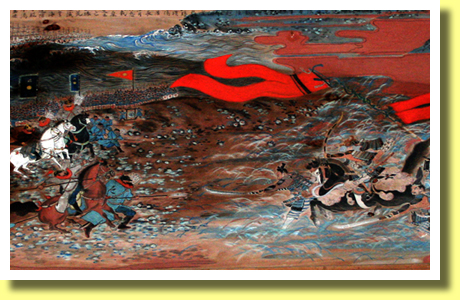
Sukekuni So, the deputy governor of the island, and a small group of samurai warriors fought against the invaders. Most of the Japanese samurai warriors, including Sukekuni So, were killed in action. Near Komodahama beach, one of the invaders landing points, Komodahama-jinja Shrine was founded to enshrine Sukekuni So and his fellow warriors. The above photo shows a part of a votive picture, depicting the battle, dedicated to the shrine.
After occupied Tsuhima and Iki Islands, the Mongolian forces landed on Hakata ( now a part of Fukuoka City, Fukuoka Prefecture, Kyushu region ), where tens of thousands warriors fought. That night a typhoon attacked the invading fleet, of which hundreds of ships were damaged or destroyed and the invading forces returned.
Again in A.D.1281, the Yuan dynasty sent another invading army, much larger than in A.D.1274, to Japan. Another typhoon made the invaders went home and the crises disappeared in tens of years. However Kamakura Shogunate could not compensate samurai warriors who were mobilized, injured and/or killed in the battles. So the authority of the Shogunate was damaged.
|
Muromachi Period
In A.D.1324, Kamakura Shogunate noticed Emperor Go-Daigo planning to overthrow the Shogunate, which exiled not the Emperor but his aides. In A.D.1331, the Shogunate detected the conspiracy of the Emperor, who was exiled to Oki Island in A.D.1332 as the retired Emperor Go-Toba was in A.D.1221. Then the Emperor Kogon was enthroned.
Even while the former Emperor Go-Daigo was confined in the island, many samurai warriors such as Masashige Kusunoki continued to fight against the Shogunate. In A.D.1333, Go-Daigo escaped the island and raised an army, against which Takauji Ashikaga, an influential general, was sent by the Shogunate to fight.

However Takauji Ashikaga sided with the former Emperor Go-Daigo. Then Yoshisada Nitta, whose statue ( above ) stands in Fuchu City, Tokyo Metropolitan Area, attacked Kamakura, where the leading figures of the Shogunate committed suicide. Then Muromachi Period started.
Emperor Go-Daigo returned to Kyoto where he restored the authority of the Imperial government and the Kenmu Restoration started. However the new government failed to satisfy many samurai warriors, who had overthrown Kamakura Shogunate.
Many samurai warriors including Takauji Ashikaga became disobedient to the Imperial edicts. So Go-Daigo started fighting against Takauji Ashikaga. However samurai warriors, who sided with Go-Daigo, such as Masashige Kusunoki and Yoshisada Nitta, were killed in action. Takauji Ashikaga returned to Kyoto where he enthroned Emperor Komyo and established Muromachi Shogunate.

Go-Daigo, who rejected to abdicate, escaped from Kyoto and run his Imperial court in Yoshino ( above ) in the mountains located in the south of Yamato Province ( now Nara Prefecture). His court is called "Southern Imperial Court" while "Northern Imperial Court" was supported by Muromachi Shogunate in Kyoto.
Go-Daigo died in Yoshino in A.D.1339 while his throne was succeeded to by his son and grandsons. The rivalry between two Imperial Courts lasted until A.D.1392 when an agreement was concluded by Emperor Go-Kameyama ( South ) and Go-Komatsu ( North ). Since then on, the throne has been succeeded to by the descendants of the Northern Imperial Family.
During Muromachi Period, Japan enjoyed the prosperity economically and culturally. International trade with china was profitable. Kinkaku-ji Temple and Ginkaku-ji Temple were built and both are now included in UNESCO World Heritage Sites. Many people including samurai warriors believed in Zen Buddhism. Many people enjoyed the tea ceremony. And so on.
However Muromachi Shogunate lost its authority and became less influential politically, economically and militarily. Many warlords, ruling provinces, fought against each other especially through the late 15th century - 16th century ( = Sengoku Jidai, the Age of Warring States ).
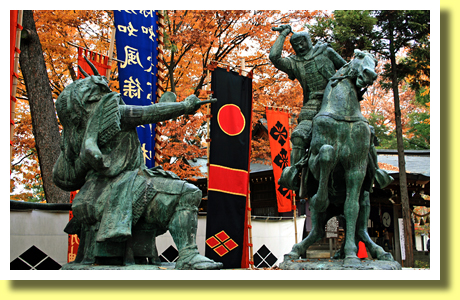
The above photo shows the statues of Shingen Takeda ( above left ) and Kenshin Uesugi ( above right ), both of whom are two of the most famous and strongest warlords in Japan at the time. Their statues stand in Kawanaka-jima ( site of their battlefield located in Nagano City, Nagano Pref., Koh-Shin-Etsu region ).
|
Azuchi-Momoyama Period
Azuchi-Momoyama Period started in A.D.1568 when Nobunaga Oda captured Kyoto, where he made Yoshiaki Ashikaga the 15th Shogun of Muromachi Shogunate. Nobunaga Oda had been one of warlords ruling a part of Owari Province ( now a part of Aichi Prefecture, Tokai region ). However he became one of the most powerful warlords after he succeeded his father in A.D.1551.
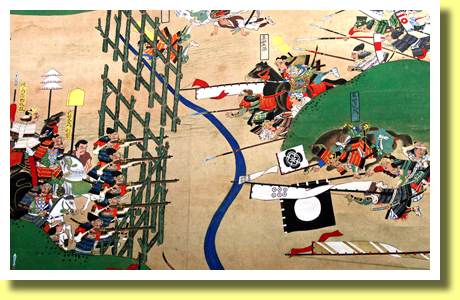
It was in A.D.1543 when Portuguese arrived in Japan with matchlocks. The production of matchlocks started in Japan in a few years. Nobunaga Oda used lots of matchlocks with innovative tactics. Above photo, taken in Nakatsu Castle ( Nakatsu City, Oita Pref., Kyushu region ), shows a part of the picture depicting the battle of Nagashino where Nobunaga Oda smashed mounted samurai warriros of the Takeda clan. It was said at the time that Takeda cavalry was the strongest.
Nobunaga Oda was innovative in various matters. He accepted Christianity to suppress Buddhism. He attacked Enryaku-ji Temple which had been one of the most influential Buddhism temples for centuries. He purged Yoshiaki Ashikaga whom he helped be the 15th Shogun of Muromachi Shogunate. He utilized the tea ceremony politically. He abolished guilds to grow commerce. So he was getting closer to the reunification of Japan when he was killed in A.D.1582 by Mitsuhide Akechi, one of his generals.
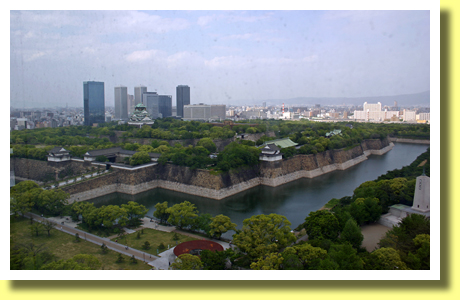
Mitsuhide Akechi was defeated by Hideyoshi Toyotomi, another one of Nobunaga's generals, who became the successor of Nobunaga Oda. In A.D.1585 Hideyoshi Toyotomi built Osaka-jo Castle ( above ), the largest castle in Japan at the time and in A.D.1590 he reunified Japan.
Hideyoshi Toyotomi disarmed farmers while he made samurai warriors live in castle towns. Also he carried out a land survey and took a census of the population. While Nobunaga Oda had built his headquarters in Azuchi, Hideyoshi Toyotomi did so in Momoyama. So their age ( A.D.1568 - 1600 ) was called "Azuhi-Momoyama Period".
|
Tokugawa Period
Edo-jo Castle was built in A.D.1457 by Dokan Ota, a samurai warrior. However Edo was a small fishing village when Hideyoshi Toyotomi moved Ieyasu Tokugawa to Edo in A.D.1590 after Hideyoshi Toyotomi completed the reunification of Japan.
Ieyasu Tokugawa strengthened and enlarged Edo-jo Castle, which became Kokyo ( the Imperial Palace ) in A.D.1869. After Hideyoshi Toyotomi died in A.D.1598, Ieyasu Tokugawa, who won the decisive battle of Sekigahara in A.D.1600, became the ruler of Japan. Then Tokugawa Period ( or Edo Period ) started.
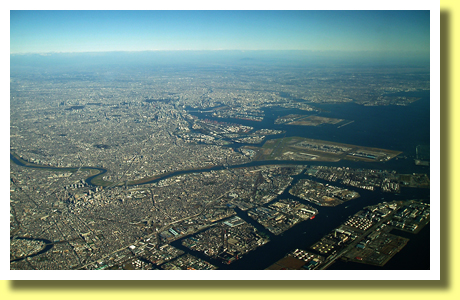
In A.D.1603 Ieyasu established Tokugawa Shogunate in Edo. It accelerated the growth of Edo, which is now Tokyo ( above ), one of the largest metropolises. In A.D.1614 and in A.D.1615, Ieyasu Tokugawa
attacked Osaka-jo Castle and Hideyori Toyotomi, a son of Hideyoshi Toyotomi, committed suicide. The destruction of the Toyotomi family stabilised the governance by the Tokugawa Shogunate.
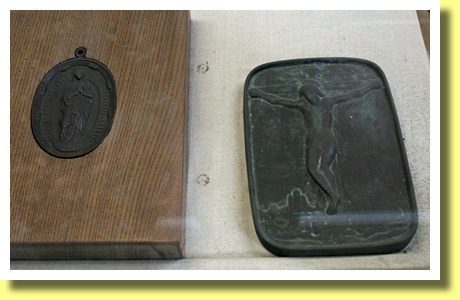
However Tokugawa Shogunate was anxious about Catholicism and European powers being threatening. So Catholicism was banned. The Shogunate forced people to step on Fumie ( tablets bearing Christian images - above are replicas exhibited in former Latin Divinity School, located near Oura Church, Nagasaki City, Nagasaki Prefecture, Kyushu region ).
Those, who failed to step on Fumie, were recognised as Christians and were ordered to abandon their religion. Those, who refused to do so, were tortured, expelled or executed. Missionaries were expelled, tortured and/or executed. The movie "Silence" based on the novel by Shusaku Endo describes the oppression.
Tokugawa Shogunate issued several edicts to enforce its national seclusion policy in the 1st half of the 17th century. Foreign ships were not allowed to enter any port in Japan except Dutch and Chinese vessels entering Nagasaki port. It was in A.D.1854 when the national seclusion of Japan was ended.
Tokugawa Shogunate had kept the society peaceful and calm on the whole for a few centuries, which enabled the economic growth. So many children learned reading, writing, calculation and so on in Terakoya ( private elementary school ), which improved literacy and numeracy.

During Tokugawa Period, many people enjoyed various kinds of entertainment such as Ningyo Joruri ( traditional puppet theatre - above photo was taken in Awa Jurobe Yashiki, Tokushima City, Tokushima Prefecture, Shikoku region ). Also people enjoyed Kabuki, Ukiyoe, Haiku and so on. Rich merchants patronised theatres and artists.
In A.D.1833, floods and cold weather caused the Great Tenpo famine, which lasted for several years. A big earthquake attacked Tohoku region in A.D.1835. There was a revolt in Osaka in A.D.1837. In addition, the Tokugawa Shogunate had been faced with the financial difficulties and taxes had been raised. The authority of Tokugawa Shogunate was diminished.

U.S.Commodore M.C.Perry and his squadron visited Japan in A.D.1853 and in A.D.1854. The above photo shows a part of kawaraban ( commercial news sheets issued during Tokugawa Period ) reporting the arrival of U.S. squadron and the landing of U.S. Marines.
After lasting negotiations, Kanagawa Treaty ( Japan and U.S. Treaty of Peace and Amity ) was signed, according to which the Shogunate opened Hakodate port in Hokkaido and Shimoda port, where U.S.Commodore M.C.Perry and his squadron entered.
Kanagawa Treaty shaked Japan and angered many samurai, who advocated "Sonno Joi" which means "Revere the emperor, eliminate the barbarians". Then Emperor baceme one of the most important key figures at the time, though Emperors had been almost nothing politically for a few centuries.
|
Copyright (c) 2021 Achi-Kochi Zanmai Co., Ltd.
|